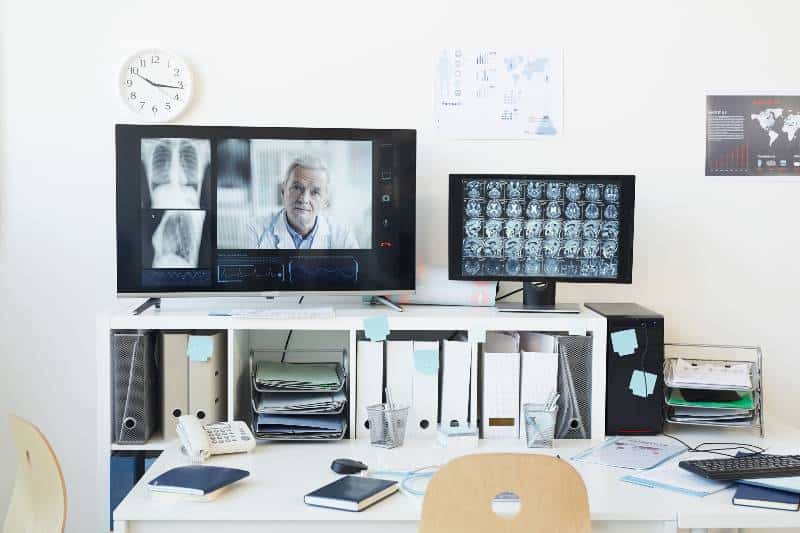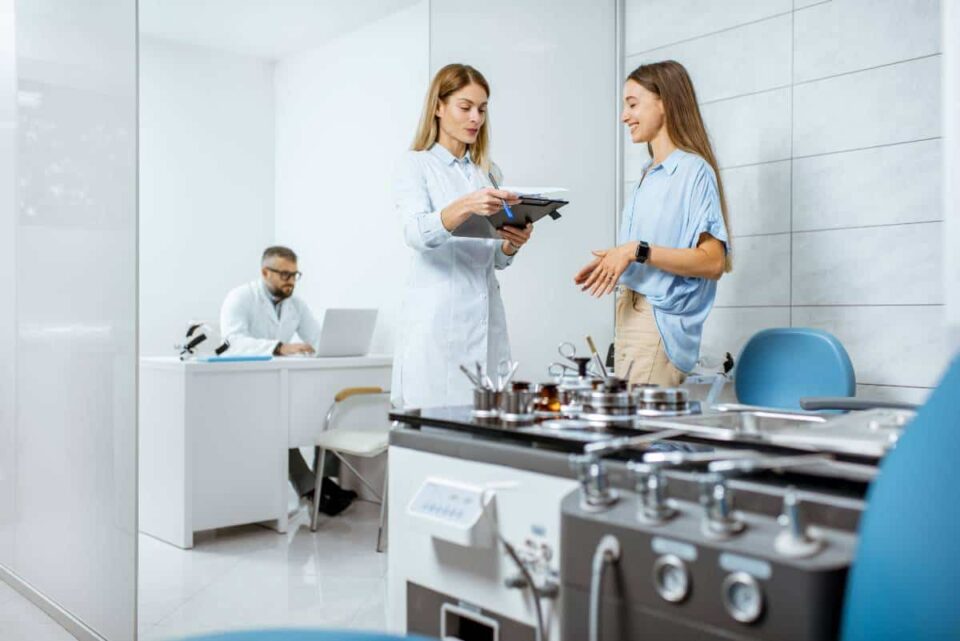Telemedicine is an evolving technology that increasingly impacts medical commercial real estate. Telemedicine, sometimes referred to as telehealth, involves providing health care remotely via digital information and communication technology.
It has had a long history of use, Telemedicine technology first began as a form of healthcare delivery in the late 1960s due to the needs of the National Aeronautics and Space Administration (NASA) and the Nebraska Psychology Institute, according to a paper written by researchers from Saint Louis University and Bentley University.
In modern times, it has become much more accepted with nearly Currently, 76 percent of U.S. hospitals connect with patients and consulting practitioners at a distance through the use of video and other technology.
The growing utilization of telemedicine is beginning to have a direct impact on medical commercial real estate by increasing the need for physical space dedicated to telemedicine operations and reducing the need for certain buildings used for traditional healthcare services. Medical commercial real estate must learn to adapt and embrace this technology to remain profitable in the coming years.
Telehealth services were utilized 38 times more frequently in February 2021 than they were before the outbreak. While the future of telehealth reimbursement parity remains unclear, there is an opportunity for payers and providers to meet the changing demands of consumers. The majority of those who have used telehealth in the past say they will do so again. Before the COVID-19 pandemic, just 11% of people used telehealth services.
Key Takeaways
- Telemedicine is an evolving technology that is increasingly impacting medical commercial real estate.
- Telemedicine technology has been around for decades and utilization is growing rapidly due to the pandemic.
- Medical commercial real estate must learn to embrace this technology to remain profitable in the future. The majority of those who have used telehealth services in the past say they will do so again. Telemedicine has the potential to reduce costs, improve access and quality of care, and reduce the need for long-distance travel.

The rise of Telemedicine
COVID-19 pandemic as a catalyst
The rise of Telemedicine has been one of the silver linings resulting from the COVID-19 pandemic. Prior to the global health crisis, doctors were reluctant to use virtual consultations as a means of providing medical care and advice.
Now, Telemedicine is becoming increasingly accepted and utilized by healthcare providers as well as patients. With long waits and limited physical space in many practices, conducting medical visits virtually provides both parties with more flexibility, convenience, and comfort – something that will likely continue even after we put the pandemic behind us!
Advantages of Telemedicine
Telemedicine has revolutionized the way healthcare is delivered, providing individuals with improved access to medical care. The rise of telemedicine has had profound implications for ensuring quality healthcare throughout diverse demographics, as well as its potential to increase efficiency for both patients and providers. With the introduction of this technology, physicians are better equipped to provide centralized services virtually from anywhere in the world.
This shift from traditional face-to-face healthcare removes common obstacles such as geography and socioeconomic factors which can otherwise make it difficult for many people to receive medical attention.
Increase in demand for Telemedicine services
The past year has seen an unprecedented rise in the demand for telemedicine services. This rapid shift is due to the convenience and time-saving offered by video chatting technology, which allows doctors and nurses to provide diagnosis and treatment without a patient needing to make an in-person appointment.
The influx of users made possible by Telemedicine has opened up new opportunities not only for healthcare professionals but also for those feeling under the weather who no longer need to leave their homes to get medical advice. The convenience made possible by this technology could revolutionize the healthcare industry in years yet to come.
Impact on Medical Commercial Real Estate
The shift toward smaller medical facilities
It’s too soon to tell how telehealth will affect medical real estate, but some believe that traditional clinics may have to make some adjustments to accommodate the growing popularity of remote care.
Given the promising future of telemedicine, certain hospitals and clinics may be able to reduce their physical footprint. It’s possible, for instance, that medical facilities can downsize their waiting spaces and/or the number of rooms available to patients. Still, it’s possible that some people merely need to make better use of the rooms they have.
Doctors who conduct both video and in-person consultations with patients will require separate waiting areas for the two methods of care delivery. Doctors conducting telemedicine consultations can sometimes benefit from a private, peaceful space in their own office. Virtual consultations might be held in flex rooms outfitted with a desk and computer, which doctors could share as needed.
Decreased demand for traditional medical office space
According to DWS, for instance, because of lower tenant turnover and longer contracts, medical office building vacancy trends are roughly 160 basis points lower than conventional offices. Lower vacancy rates can be attributed to the shortage of available housing. Despite an initial rise at the start of the pandemic, medical office vacancy has been steadily decreasing every year since 2009. Meanwhile, medical office net absorption has been increasing at a faster rate than traditional office net absorption, especially since the start of the pandemic, which devastated the traditional office market.
Despite the fact that demand for medical offices is mostly being driven by Baby Boomers, the demographic makeup of MOB buildings is shifting due to the influence of Millennials. Millennials are driving up demand for medical offices that are convenient, flexible, and provide a wide range of services that can be accessed quickly and on demand.
Learn more here on what factors influence the demand for medical office space, this blog will help you to further understand the potential of medical office space investments.
Repurposing of medical office buildings
COVID has also hastened another trend in healthcare: the transition from expensive in-hospital care to less expensive outpatient clinics.
Many people, fearing contact with COVID-positive patients or employees, avoided visiting large urban hospital campuses at the height of the crisis. Many people have shifted to getting the same service in ambulatory care settings or other outpatient clinics.
Patients quickly came to prefer these suburban clinics to navigate the maze of a traditional hospital, which was sometimes located far from their homes. Outpatient centers ultimately won out as the most practical option for the general public.
The future of healthcare property will be affected by this trend. The need for outpatient medical office buildings, also known as ambulatory care facilities, is expected to increase as more individuals choose closer-to-home care. Because of the high cost involved, new healthcare properties are rarely created on a speculative basis. As a result of a lack of new buildings, certain service providers may consider converting former retail and warehouse areas into medical facilities.
Increased demand for technology-enabled medical facilities
Medical technology is nothing new, thus that point can’t be disputed. From the most serious conditions to the most common ones, like broken bones, we rely on medical technology. Technology has always been present and undeniable, from plaster to robotic surgery. However, the patient is always at the center of medical innovation.
Many significant technological advances have been made in healthcare in recent years:
The use of three-dimensional printing has been widespread for some time. Medically, it’s used to make artificial organs and replacement joints. It is also widely used in the field of prosthetics due to its ability to produce anatomically accurate replacement limbs.
When a patient receives an artificial organ, it functions similarly to a real organ and is not rejected by the immune system. This emerging field of healthcare technology sometimes referred to as bio-printing, has the potential to improve the lives of millions of people each year.
The goal of robotic surgery is to do minimally invasive procedures with as much control, precision, and flexibility as feasible for both the surgeon and the patient. It has made it simpler or even feasible to carry out previously impossible tasks.
Wearable health technology originally emerged as a fitness tool for monitoring vitals like heart rate and step count, but their applications in healthcare quickly became clear.
Wearable devices for monitoring health
In recent years, virtual reality (VR) has seen widespread adoption, primarily for recreational purposes. However, VR can provide pupils with a visual comprehension of human anatomy and a “real world” experience with treatments.
When it comes to healthcare online, the rapidly expanding telehealth visits is an exciting prospect. Diagnostic and professional medical counsel are readily available to patients, and they can contact their doctor whenever they need them. A website creator and customer relationship management system (CRM) will be necessary for this.
The future of Telemedicine and Medical Commercial Real Estate
Integration of Telemedicine into traditional medical facilities
Telemedicine is revolutionizing the way healthcare functions, and its increasing prevalence has made it vital for medical-oriented commercial real estate to become more efficient. For example, better administrative health systems must be implemented in order to cater to all types of patient visits: from traditional ones to hybrid encounter models.
Additionally, buildings should feature appropriate equipment that enables online consultations; this could give best-in-class building owners an edge as they offer a modernized experience with improved access.
Development of hybrid Telemedicine and traditional medical facilities
As technology continues to advance, so too does the potential for innovative solutions within healthcare. Telemedicine and similar virtual platforms have opened up a world of opportunity where traditional medical establishments can be enhanced with cutting-edge digital elements – providing more efficient use of physical clinical space while ensuring cost-effective services through modern technologies. As we move forward in this realm there is no limit to what advancements can be made which will ultimately benefit not only patients but also those working in the industry itself.
Evolution of medical office design
Improvements in technology and patient care have led to a revolution in the layout of medical facilities. It has taken a long time for medical or clinical buildings to catch up to the latest trends in interior design. Many of them look very much like they did a few decades ago. Fortunately, improvements are being made gradually as more focus is placed on making greener buildings and constructing environments tailored to people.
These days, patients can rest assured that their visits to the doctor will be more pleasant than ever thanks to the modern aesthetic and patient-centric architecture of today’s medical office buildings.
The following are some current tendencies in the stylish and functional layout of medical facilities:
Construction of More Energy-Efficient Structures
One trend in building design that has benefited all sectors is the erection of greener, more energy-efficient structures. Because of the high energy needs of the healthcare business, medical facilities provide excellent candidates for green or energy-efficient building design. A clinical office, with its high-powered machines, strong lighting, and critical climate control needs, is already one of the top energy consumers among buildings.
When constructing a new medical facility, it’s important to choose cutting-edge, long-lasting materials for the building’s envelope. Construction of these structures is best accomplished with insulated concrete wall systems. They’re stronger than ordinary concrete walls, go up more quickly, and keep out air and moisture better than you’d expect.
Adapting To New Digital Environments
As the use of digital technology in healthcare real estate continues to grow, it is important that the interior design of medical facilities keep up. When it comes to healthcare organizations, technological advancements are constant and efficiency-enhancing. Use of digital kiosks where patients may check themselves in and out and schedule follow-up appointments, for instance, can ease pressure on receptionists and free them up to deal with other matters.
Plenty of well-spaced outlets, and perhaps even some upgraded outlets with USB connections, should be available in public areas like waiting rooms and workplaces. It is crucial to take advantage of technological advances that boost patient happiness and make employees’ work easier.
Growth opportunities in technology-enabled medical real estate
The biopharmaceutical industry is continuing to make significantly large investments, with total U.S. R&D spending reaching an all-time high of $179 billion in 2018 and expected to rise by another $34 billion before 2024!
With the number of medications under development climbing 46% since 2015, this has created a knock-on effect across many areas: top talent is being drawn towards companies due to their cutting-edge facilities; investors have been keener than ever to get involved; and resources for growth become available much easier – making it clear that now is the time for biotech firms around America (and beyond!) to shine brighter than ever.
The cost of innovation in pharmaceuticals has soared to unprecedented heights, rising over 45% within the last decade. Yet at the same time research and development returns for large-cap biopharmaceutical businesses have plummeted, dropping from a 10% average in 2010 down to just 1.9%.
With healthcare systems demand on an upward trend and expected sales predicted to increase by up to 45%, it is ever more critical that pharma companies make wise decisions when it comes to their real estate investments as well as access cutting-edge infrastructure and talent pools – not only if they want to stay competitive but also survive during this lucrative yet challenging period.
Here are some additional headers and content on telemedicine disrupting medical real estate and the future of care:
Telemedicine Transforming the Healthcare Industry Landscape
The telemedicine revolution drives opportunity through new strategic partnerships, tech-enabled buildings, and patient reach expansion. Healthcare real estate must evolve alongside to support virtual/hybrid care models.
Preparing Assets for Flexible Utilization
Medical office space able to fluidly accommodate both in-person and telemedicine will best position property owners for long-term viability. Assess floorplans, tech needs, privacy capabilities and build resiliency.
Partnering Technology Firms and Healthcare Providers
Strategic alignments between health companies and tech partners fuel telemedicine advancement. Collaboration drives innovation in care delivery, better patient experiences and specialty access.
Characteristics of High-Value Partnerships
Look for tech companies with proven healthcare solutions able to enhance delivery and economics. Ensure shared commitment to expanding patient reach and outcomes.
Warehouse Telemedicine Capabilities
On-site medical care via telemedicine kiosks limits workforce downtime. Warehouse owners gain competitive advantage providing easily accessible virtual health access.
Evaluating Onsite Telemedicine Viability
Assess workforce size, injury rates, insurance costs, and lost time to model the value of installing onsite telemedicine rooms. This emerging differentiator also signals a commitment to employee wellbeing.
Telemedicine Impact On Medical Commercial Real Estate FAQs
What is Telemedicine and how does it work?
With the use of telemedicine, you can have a virtual visit with a doctor. And you can put off going to the doctor or hospital. Through telemedicine, patients and doctors can have face-to-face discussions online regarding health concerns and symptoms.
How has the COVID-19 pandemic affected the growth of Telemedicine?
The private sector’s utilization of telemedicine has expanded dramatically due to COVID-19. Telemedicine has been adopted by the medical community as a means to circumvent lockdown regulations, triage patients, lessen the need for direct patient contact, and continue earning a living.
What is the impact of Telemedicine on Medical Commercial Real Estate?
As the pandemic continues to force lifestyle adaptations, senior living communities are rising up to meet the challenge. The future of healthcare delivery is being shaped by telehealth technology – retirement homes that actively embrace and accommodate it have found success with their existing residents as well as potential new inhabitants looking for an innovative approach when considering a place to live out their golden years.
What is the future of Telemedicine and Medical Commercial Real Estate?
The future of telemedicine is bright, as it will continue to play an ever-growing role in health care. Telemedicine has already made a big impact on the medical commercial real estate industry, and its growth will likely expand further as technology advances. With telemedicine growing exponentially, there will be opportunities for developers to build specialized medical commercial real estate that is optimized for telemedicine.
This can include medical office buildings, virtual care centers, co-working spaces, and other types of properties that are specifically designed to accommodate the needs of telemedicine providers.
What are the benefits of Telemedicine for patients and medical professionals?
There are countless benefits of telemedicine for both patients and providers. For patients, there is the convenience of being able to access health care from their homes or offices, which makes it easy to fit into a busy lifestyle.
Telemedicine also provides access to specialists in far-flung areas who may not be available in the patient’s local area. In addition, since providers can manage a higher volume of patients in less time, costs are reduced for both parties, making health care more affordable for patients.
How Will Telemedicine Impact the Future of Healthcare?
Telemedicine is poised to transform healthcare through increased access, convenience, and efficiency. As telehealth platforms partner with medical and commercial providers, patients nationwide can consult doctors online for minor illnesses or preventative care instead of going to overloaded hospitals and clinics. Logistics companies are even installing telemedicine kiosks in warehouses so workers can promptly receive remote diagnoses and treatment. The COVID-19 pandemic necessitated virtual leveling-up across the healthcare industry, lighting a fuse for telemedicine explosion. Moving forward, telehealth will likely be embedded in standard health services, meeting patient needs through expanded medical partnerships and innovative delivery options like workplace telemedicine rooms.
Conclusion
The rise of Telemedicine has been one of the silver linings resulting from the COVID-19 pandemic. Prior to the global health crisis, doctors were reluctant to use virtual consultations as a means of providing medical care and advice, however, they have since come to see the many benefits that this technology provides. Not only is Telemedicine more convenient for patients, but it also offers opportunities for cost savings and greater efficiency in the delivery of care.
As we look to the future, it is clear that Telemedicine is here to stay and will continue to revolutionize how a healthcare company is delivered. Investors and stakeholders in the Medical Commercial Real Estate industry would be wise to take note of this trend and consider how it may impact their business.
At Tolj Commercial, we are closely monitoring these developments and stand ready to assist our clients in making informed decisions about their investments. If you would like to learn more about how Telemedicine may impact your Medical Commercial Real Estate holdings, please call or schedule a consultation with me today.




